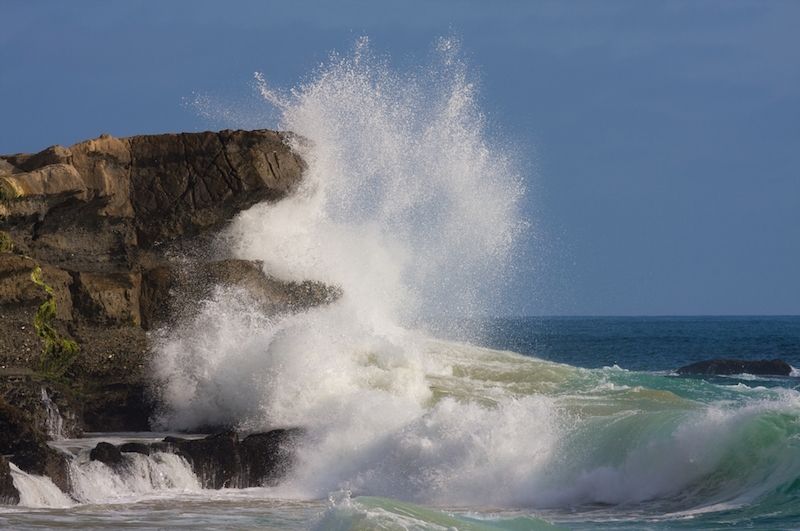62-Foot Wave Off Iceland Smashes World Record

A monstrous swell in the North Atlantic that rose up as high as a six-story building is now the world's tallest wave measured by a buoy, according to the World Meteorological Organization (WMO).
The wave crashed down the morning of Feb. 4, 2013, in the watery expanse between Iceland and the United Kingdom, at approximately 59 degrees N, 11 degrees W. It occurred after a strong cold front passed through the area, producing winds of up to 50.4 mph (43.8 knots), the WMO reported.
The North Atlantic is a prime setting for smashing big-wave records. The previous buoy-measured record of 59.96 feet (18.275 m) also occurred in the North Atlantic, on Dec. 8, 2007, as did the tallest wave measured from a ship — a 95.03-foot-tall (29.05 m) swell on Feb. 8, 2000, the organization said. [See Photos of Monstrous Ocean Waves]
"This is the first time we have ever measured a wave of 19 meters. It is a remarkable record," Wenjian Zhang, the assistant secretary-general of the WMO, said in a statement. "It highlights the importance of meteorological and ocean observations and forecasts to ensure the safety of the global maritime industry and to protect the lives of crew and passengers on busy shipping lanes."
The WMO added that the new record isn't from one wave, but rather an average of 10 to 15 wave heights, which "is a more reliable measure of wave height than that of a single wave," said Randall Cerveny, a scientist at the WMO. "Of course, maximum waves have been recorded up to 29 meters [95.1 feet]," Cerveny told Live Science, but the WMO began using averages in 2007 so that their records would be more accurate, he said.
The buoy that recorded the massive wave is part of the Marine Automatic Weather Stations, run by the U.K.'s national weather service, called the Met Office. This buoy, as well as others in the network, helps the WMO and its partners monitor the oceans, and complements measurements taken by satellites and ships.
"We need high-quality and extensive ocean records to help in our understanding of weather [and] ocean interactions," Zhang said. "Despite the huge strides in satellite technology, the sustained observations and data records from moored and drifting buoys and ships still play a major role in this respect."
Sign up for the Live Science daily newsletter now
Get the world’s most fascinating discoveries delivered straight to your inbox.
He noted that wave height is defined as the distance from the crest of one wave to the trough (the lowest part) of the next wave.
The highest waves usually happen in the North Atlantic because wind-circulation patterns and atmospheric pressure in the winter lead to intense, extratropical storms called "bombs." That makes the region from the Canadian coast around Newfoundland to the south of Iceland and to the west of the United Kingdom a prime spot for these thunderous wave records.
"The new world record will be added to the official WMO archive of weather and climate extremes, which is being constantly updated and expanded thanks to continued improvements in instrumentation, technology and analysis," said Randall Cerveny, the joint rapporteur on world records of climate and weather extremes for the WMO. (A rapporteur is a person appointed by an organization to report on the proceedings of meetings. In the WMO case, the rapporteur keeps an official, unbiased list of world weather extremes.)
"Oceans cover some 70 percent of the world's surface," Cerveny said. "Ocean observations are therefore critical to understanding and forecasting our weather and climate.
The WMO also archives the world's highest and lowest temperatures, rainfall, heaviest hailstone, longest dry period, maximum gust of wind, as well as hemispheric weather and climate extremes, the organization said in the statement.
Earlier this year, the WMO confirmed the longest reported distance for a lightning bolt (in Oklahoma) and the longest duration for a single lightning flash (in southern France).
Original article on Live Science.
p.p1 {margin: 0.0px 0.0px 0.0px 0.0px; font: 14.0px Calibri; -webkit-text-stroke: #000000} span.s1 {font-kerning: none}

Laura is the archaeology and Life's Little Mysteries editor at Live Science. She also reports on general science, including paleontology. Her work has appeared in The New York Times, Scholastic, Popular Science and Spectrum, a site on autism research. She has won multiple awards from the Society of Professional Journalists and the Washington Newspaper Publishers Association for her reporting at a weekly newspaper near Seattle. Laura holds a bachelor's degree in English literature and psychology from Washington University in St. Louis and a master's degree in science writing from NYU.











